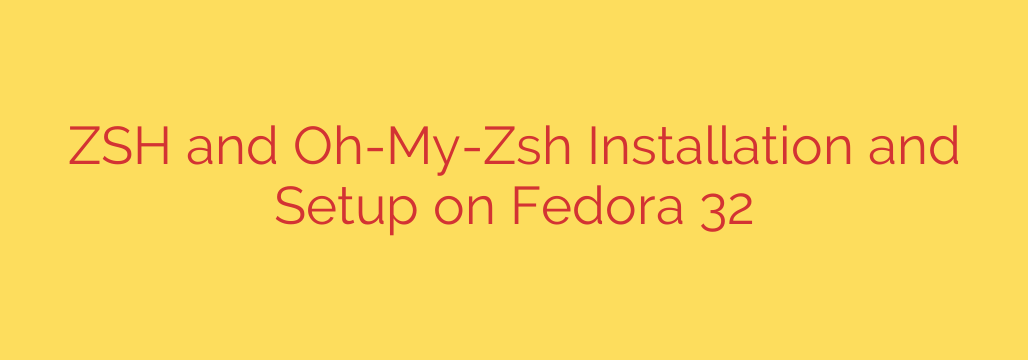
Unlock Your Fedora Terminal: A Complete Guide to Installing Zsh and Oh-My-Zsh
If you spend any amount of time in the command line on Fedora Linux, you’re likely familiar with the default Bash shell. It’s reliable and gets the job done. But what if your terminal could be smarter, faster, and more visually appealing? Enter Zsh (the Z shell), a powerful and highly customizable shell that can dramatically improve your command-line productivity.
When paired with the Oh-My-Zsh framework, Zsh transforms from a powerful tool into an intuitive and personalized command center. This guide will walk you through the entire process of installing and configuring Zsh and Oh-My-Zsh on your Fedora system, unlocking a new level of efficiency.
Why Upgrade from Bash to Zsh?
Before we dive into the installation, let’s look at what makes Zsh a compelling upgrade:
- Intelligent Autocompletion: Zsh offers advanced tab completion that not only completes commands and file paths but also provides options and arguments for many common tools.
- Automatic
cd: Simply type the name of a directory and press Enter; Zsh will navigate into it without needing thecdcommand. - Plugin and Theme Support: This is where Zsh truly shines, especially with Oh-My-Zsh. You can easily add powerful plugins and change the entire look and feel of your prompt with beautiful themes.
- Spelling Correction: Mistype a command? Zsh can automatically suggest the correct one.
Step 1: Installing Zsh on Fedora Linux
First, we need to get Zsh installed on your system. Fedora’s repositories make this a straightforward process.
Open your terminal.
It’s always a good practice to ensure your system is up-to-date before installing new packages. Run the following command:
bash
sudo dnf update
Next, install Zsh using the
dnfpackage manager:sudo dnf install zshEnter your password when prompted and press
yto confirm the installation.To verify that Zsh was installed correctly, check its version:
bash
zsh --version
You should see an output displaying the installed Zsh version.
Step 2: Setting Zsh as Your Default Shell
While Zsh is now installed, your terminal will continue to use Bash by default. To make Zsh your permanent shell, you need to change it for your user account.
- Use the
chsh(change shell) command to set your default shell to Zsh. The command below finds the path to the Zsh executable and sets it as your login shell.
bash
chsh -s $(which zsh)
- This is a critical step: For the change to take effect, you must log out of your Fedora session and log back in. Simply closing and reopening the terminal window is not enough.
After logging back in, open a new terminal. You should be greeted with the Zsh first-time configuration prompt. You can press 2 to populate your ~/.zshrc file with the recommended default settings. This file is the main configuration hub for Zsh.
Step 3: Supercharging Your Terminal with Oh-My-Zsh
Oh-My-Zsh is a community-driven framework for managing your Zsh configuration. It simplifies the process of using themes and plugins, making customization incredibly easy.
To install Oh-My-Zsh, you can run their official installation script using either curl or wget.
Using curl (most common):
sh -c "$(curl -fsSL https://raw.github.com/ohmyzsh/ohmyzsh/master/tools/install.sh)"
Using wget:
sh -c "$(wget https://raw.github.com/ohmyzsh/ohmyzsh/master/tools/install.sh -O -)"
Running this command will download and execute the installation script. It will automatically back up your existing ~/.zshrc file and create a new one for Oh-My-Zsh. Once it’s finished, your terminal prompt will immediately look different, confirming the installation was successful.
Step 4: Customizing Your Zsh Experience
The real power of this setup comes from customization. All your settings are controlled within the ~/.zshrc file located in your home directory. You can edit this file with any text editor, such as nano or gedit.
nano ~/.zshrc
Changing Your Theme
Oh-My-Zsh comes with hundreds of pre-built themes. The default is robbyrussell, but you can find one that suits your style.
- Find the line in
~/.zshrcthat says:ZSH_THEME="robbyrussell" - Change
robbyrussellto the name of another theme. A popular and powerful theme isagnoster, which requires installing a Powerline font for special characters to display correctly.
bash
# To install Powerline fonts on Fedora:
sudo dnf install powerline-fonts
- Update the line in your
.zshrcfile:
ZSH_THEME="agnoster" - Save the file and exit the editor.
Adding Powerful Plugins
Plugins add new features and workflows to your shell. Oh-My-Zsh enables the git plugin by default, which provides useful aliases and functions for Git users. You can enable more by adding them to the plugins array in your .zshrc file.
Find this line:
plugins=(git)
You can add more plugins by separating them with spaces. Two highly recommended plugins are zsh-autosuggestions and zsh-syntax-highlighting. These are not included with Oh-My-Zsh by default, so you must install them first.
Install
zsh-autosuggestions: This plugin suggests commands as you type based on your history.git clone https://github.com/zsh-users/zsh-autosuggestions ${ZSH_CUSTOM:-~/.oh-my-zsh/custom}/plugins/zsh-autosuggestionsInstall
zsh-syntax-highlighting: This plugin highlights commands in the shell, helping you spot syntax errors before you even press Enter.git clone https://github.com/zsh-users/zsh-syntax-highlighting.git ${ZSH_CUSTOM:-~/.oh-my-zsh/custom}/plugins/zsh-syntax-highlightingNow, add them to your
~/.zshrcfile:
plugins=(git zsh-autosuggestions zsh-syntax-highlighting)
Step 5: Applying Your Changes
After editing your ~/.zshrc file, you need to apply the changes. You can do this by either closing and reopening your terminal or by running the following command:
source ~/.zshrc
Your terminal will instantly reload with your new theme and plugins enabled. You’ve now successfully transformed your standard Fedora terminal into a modern, efficient, and personalized command-line environment. Enjoy exploring the vast ecosystem of themes and plugins to further tailor it to your workflow
Source: https://kifarunix.com/install-and-setup-zsh-and-oh-my-zsh-on-fedora-32/








